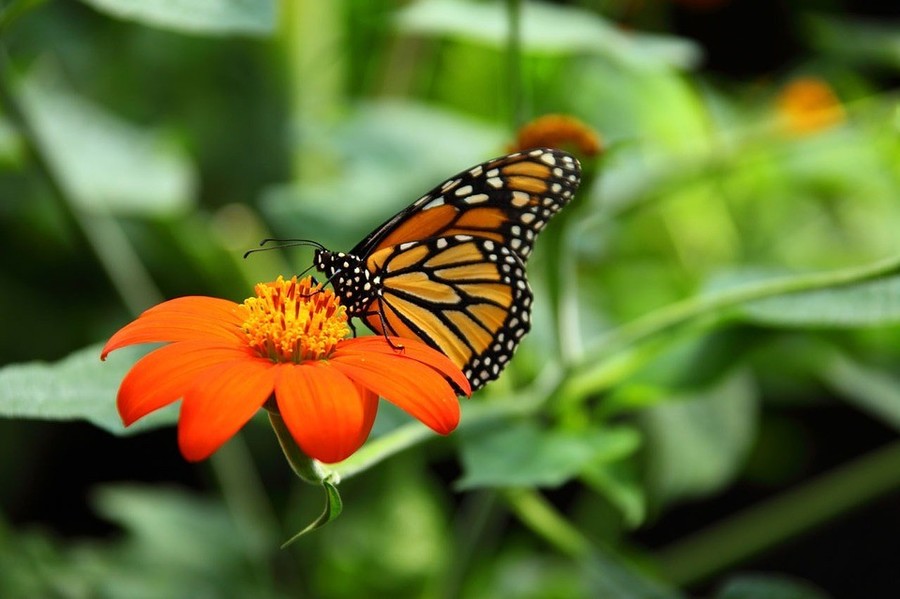Queen of the garden now flits from flowery throne to throne
Green scene
Once again, on Aug. 5, I was sitting at my desk from which I spotted my first hummingbird of the year and I sensed motion. The Joe Pye weed is blooming well this year, and atop the long stalks I saw a gorgeous Monarch – Danaus plexippus – alighting on the clumps of small pink flowers. I let out a yell and everyone in the house came running. I would like to know if other readers are also spotting those butterflies.
The public is, by now, well aware that the Monarch is endangered. Numbers of butterflies returning to their overwintering sites in California and Mexico are seemingly much smaller, judging by the reduced amount of acreage covered by butterflies.
Two years ago, I bought and planted a milkweed plant in my effort to help visiting Monarchs, as well as induce them to visit my garden. Although the “weed” part of the plant name indicated that I should have too many plants within a few years, I never saw mine again. Therefore, a few weeks ago I went out and bought another plant that had finished blooming but was filled with seed pods. I will, once again, look for a good garden location for it but, in addition, I now have seeds that, I hope, will rapidly increase the number of plants. According to the United States Department of Agriculture (USDA), seeds should be collected from ripe pods before they open – they are wind dispersed, and once the pod opens, presumably, the seeds will be quickly gone – and planted in the fall, since they require chilling for three months in order to germinate. Otherwise, they can be chilled in the refrigerator over the winter and planted while the soil is still quite cool in the spring.
Our view of Monarchs is a very simple one. They overwinter far away, migrate across the U.S. during the spring, and return to their winter sites in the fall. But so much else is happening below the radar! In fact, the spring migrating butterflies are long dead by the following fall, and it is their great-great grandchildren who are returning to places they have never seen. Those great-great grandparents lived four to five months in their winter location – supposedly in the same trees (in California, eucalyptus trees, in Mexico, oyamel fir trees) that their ancestors hibernated on – and about six months altogether. In February-March, the butterflies begin to awaken, mate and start their northward migration. Incidentally, according to migration maps, our local Monarchs are actually coming from Mexico or possibly southern Florida. March-April sees the first generation, May-June the second generation, July-August the third and September-October the fourth. This last generation migrates southward for the winter and does not mate until February-March when it begins the northward migration.
Monarch females need to lay their eggs on one of many varieties of milkweed plants – genus Asclepias. The female will not lay more than one egg per plant, since the caterpillar is a voracious eater and spacing guarantees enough food. The egg is attached on the underside of a leaf and hatches after four days into a caterpillar. The caterpillar is an eating machine, and as it grows too fat for its skin, it molts – sheds the old skin – five times over 10 to 14 days, while growing from 2-6 millimeters all the way to 25-45 millimeters in length. It then forms its cocoon – the pupa – and metamorphoses over 10-14 days, and emerges as the gold and black creature that we look so much forward to. The adult, with the exception of the migrating generation, lives between two and five weeks, and the cycles keep repeating. As adults, Monarchs stop eating milkweed leaves and need nectar-producing plants to feed on. Spring flowering nectar plants include chives, Siberian wallflower and May Night Salvia. Later bloomers include blue cardinal flower, zinnias, and, not surprisingly, Joe Pye weed. For a guide on how to attract specific butterflies, visit www.thebutterflysite.com/butterfly-food.shtml. It should be noted that alkaloids derived from milkweeds make Monarch caterpillars and adults unpalatable and dangerous to predators.
But are lack of habitat and milkweed shortage the only problems for the Monarch? Hardly. Three other factors are now being cited also. One is called habitat fragmentation. Highways now crisscross our country, and many butterflies end up smashed into cars as they migrate. Factors two and three are closely related. Drought, floods and severe weather heavily impact the availability of nectar-producing flowers that the butterflies need in order to migrate safely and maintain health.
As we examine problems that seem straightforward, we eventually learn that there are myriad other factors involved and each is too important to ignore.






